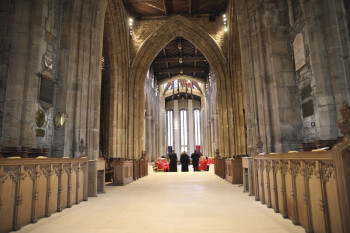Designing furniture for churches
Any project that involves designing new furniture for an old building demands a sensitive approach, and this is particularly true when designing furniture for churches or for any building that has architectural, cultural or religious significance.
Over the past year, we have been working with Wakefield Cathedral to design and create a new altar and ambo for the newly refurbished nave.
We needed to create a link between the history and grandeur of this beautiful building and the demands and practicalities of modern life.
The redevelopment was called Project 2013, which indicates the motivation behind it: ensuring the historic building was equipped to serve its modern congregation.
This need to cater for the future without losing touch with the past is something many places of worship are concerned about and it can be hard to find the right balance between old and new, traditional and modern.
Modernisation usually involves giving attention to the basics: a new boiler, better insulation, improved lighting and a good clean-up of the old stonework. A new kitchen and toilets may also be part of the plans, along with perhaps a smartened-up entrance to make the building more inviting.
What can get overlooked when designing furniture for churches, however, is the furniture itself. Getting the right furniture, which combines the traditions of the building with modern style and practicality, can be the essential finishing touch that brings everything together.
A recent article in the Church Times, which featured our work for Wakefield Cathedral, tackled the issue head on.
It included a quote from Catherine Townsend, who helped to run a competition for people to design a church chair as part of a focus on raising the standard of furniture in churches.
She said: “Often, we found that churches were tagging furniture on at the end of a reordering project, whereas, in fact, good furniture design really completes a scheme. We want churches to think ‘Yes, this might be cheap now, but what about its longevity?’”
As well as making a traditional space more inviting for modern congregations and communities, new furniture for churches can be designed to suit its current purpose.
For Wakefield Cathedral, for example, the altar and ambo both needed to be movable so they can be stored out of the way when they aren’t needed.
Modern churches aren’t just about services on Sunday; they’re in use throughout the week by all sorts of different groups, so being able to adapt the space easily to changing demands and needs is vital.
Good design, quality construction, sensitivity towards the building’s character and an understanding of the purpose of both the furniture and its setting are the essential ingredients when it comes to designing furniture for churches, cathedrals and places of worship.

